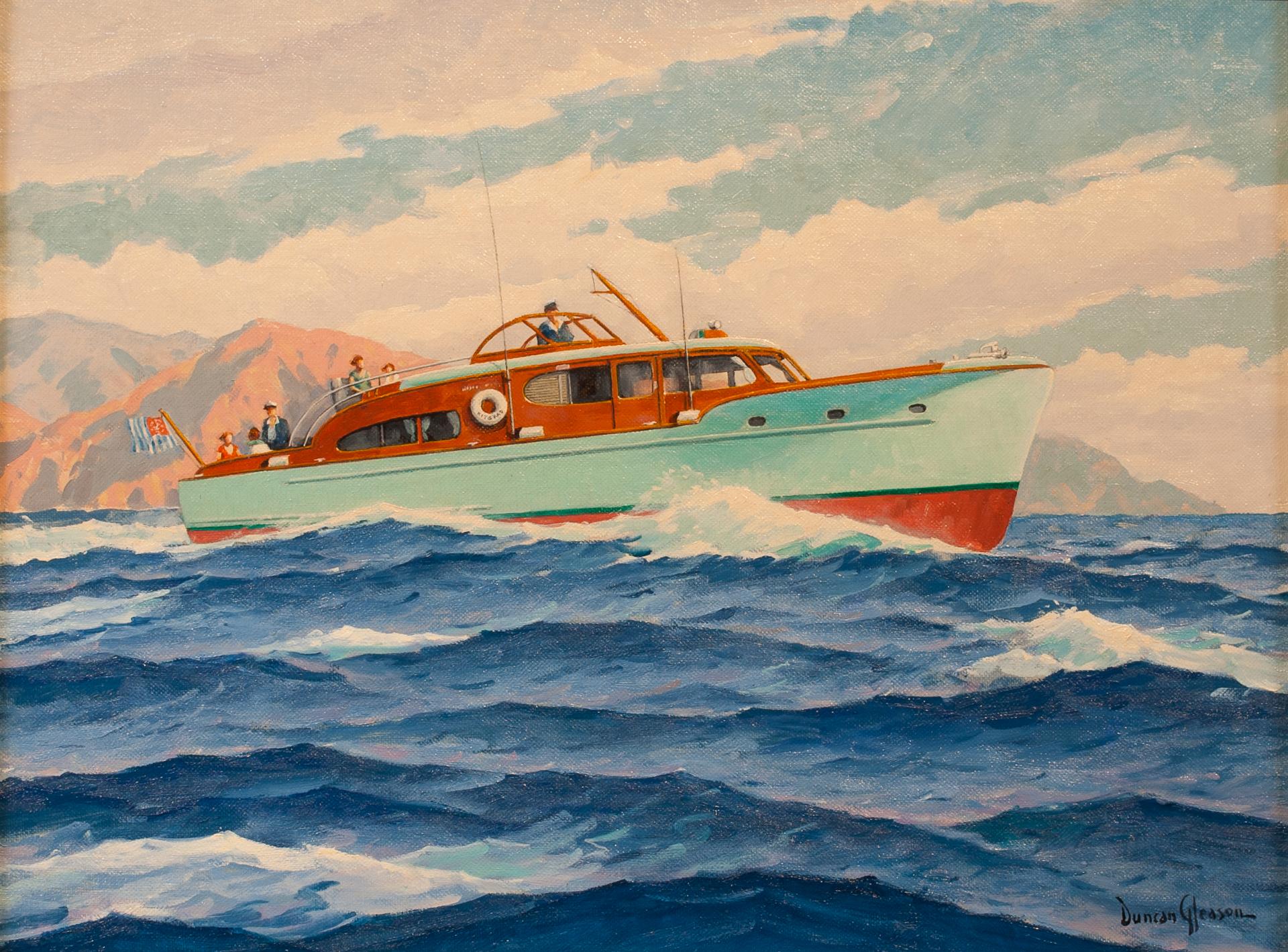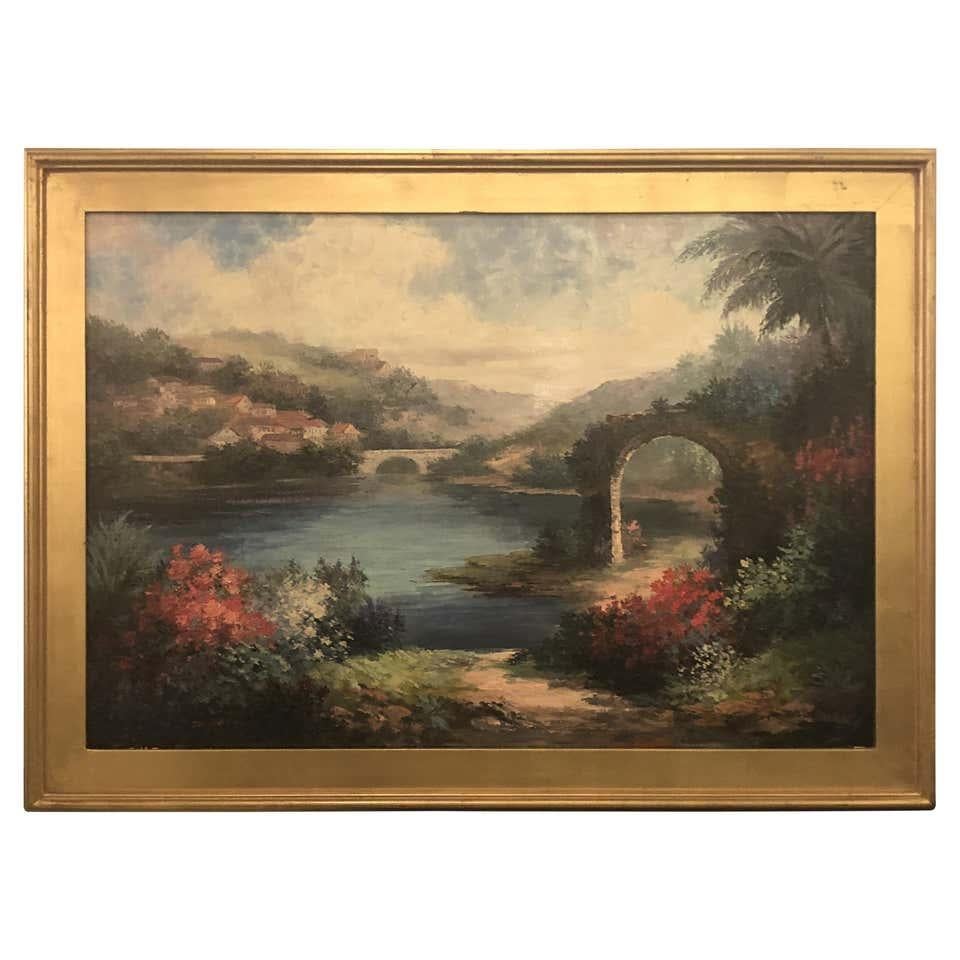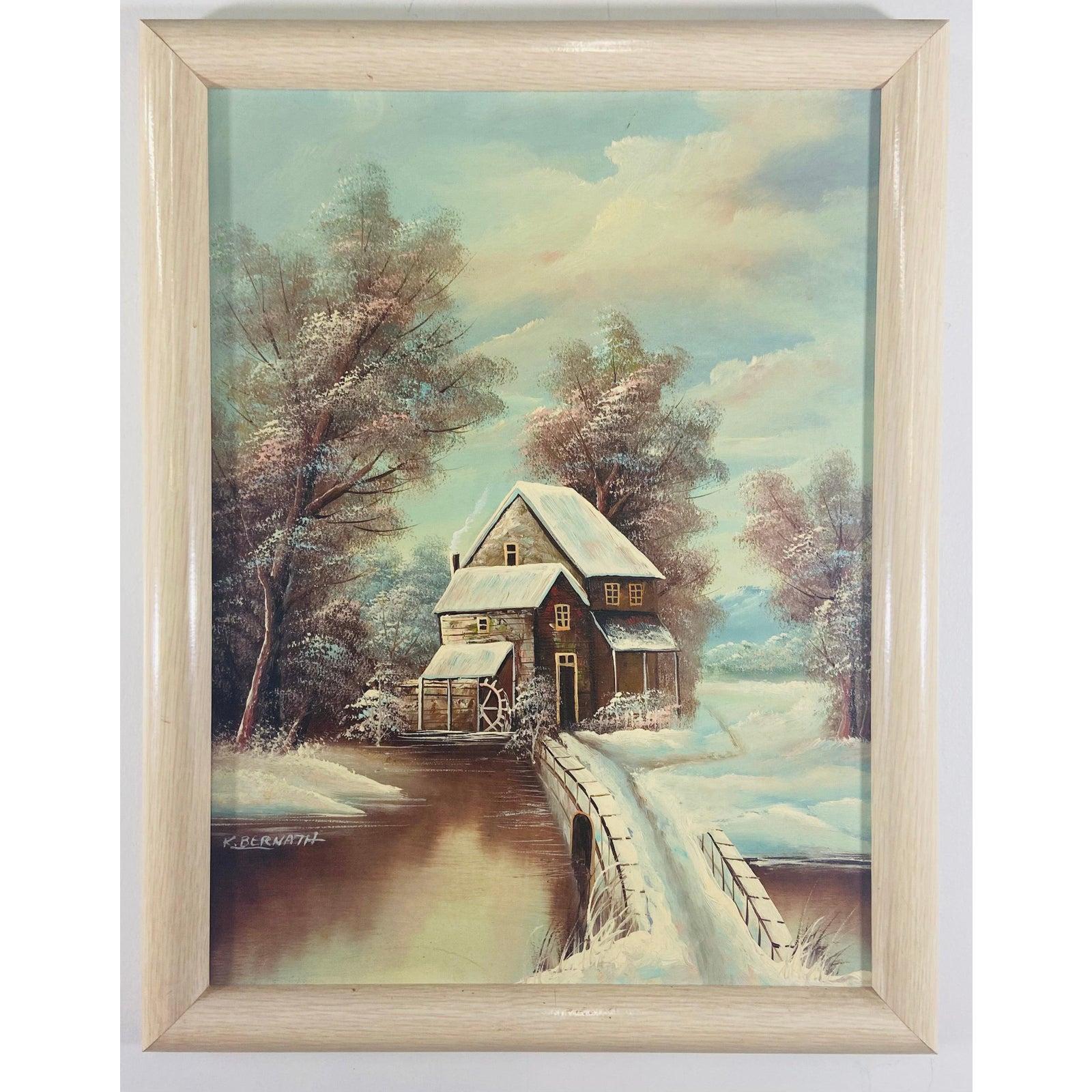Items Similar to Spring in Dorset, 20th Century English Oil Landscape, Female Artist
Want more images or videos?
Request additional images or videos from the seller
1 of 6
Marjorie SherlockSpring in Dorset, 20th Century English Oil Landscape, Female Artist1952
1952
About the Item
Oil on board
Image size: 12 1/2 x 15 1/2 inches (31.75 x 40 cm)
Contemporary style handmade frame
Exhibitions
1952 Royal Academy of Arts Exhibition, Gallery no. VII, no.429.
This forest scene invites the viewer into a multi-sensory event where the cool, damp shadows of the foliage can almost be felt and the rich bouquet of the forest floor recalled. Here, Sherlock has chosen a somewhat unusual angle and composition, dissecting each truck and tree form so that only a part can be seen. Furthermore, as we look into the depths of this space it becomes clear that we are stood gazing down into a valley that is in the distance, behind this wooded area. Indeed, instead of giving us an uninterrupted view of this vista, as perhaps would be expected, this view is deliberately blocked and our focus is directed instead towards the organic forms in the foreground.
The Artist
Marjorie Sherlock was born at Fir Tree Cottage, George Lane, Wanstead, Essex, on 3 February 1891, the elder child of the civil engineer, Henry Sherlock, and his wife, Alice (née Platts), who was born in Benares, India. By 1901, the family was living at ‘The Limes’, 121 Mill Road, Cambridge, and Marjorie received an education locally. In 1918, she entered into marriage with her cousin, Major Wilfrid Barrett, though this proved unsuccessful and they later divorced (he remarrying in 1941). She then continued to live at the family home until the Second World War.
During the First World War, Marjorie Sherlock studied at Westminster Technical Institute under the Camden Town School painters, Walter Sickert and Harold Gilman.
She exhibited at the Royal Academy of Arts from 1917, when she showed a powerful view of the interior of Liverpool Street Station (Government Art Collection) (to which the current etching [202] relates). In time, she would exhibit at the International Society, the New English Art Club, the Royal Society of British Artists, the Society of 207 Graphic Art and the Women’s International Art Club (becoming a member of the last two). She also showed work internationally.
Developing as a printmaker as well as a painter, Sherlock studied etching under Malcolm Osborne at the Royal College of Art in 1925. She published her etchings in four series, the titles of which indicate her love of travel: ‘English Etchings, ‘Egyptian Etchings’ (both 1925), ‘German Etchings’ (1929) and ‘Indian Etchings’ (1932). During this period, she also visited the united States. More admiring of Continental painters than British ones, she furthered her studies, in 1938, by working in Paris under André L’Hôte and André Dunoyer de Segonzac.
During the Second World War, Sherlock moved to East Devon and settled at Oxenways, a Victorian hunting lodge, near Membury and north of Axminster. Of forceful and resourceful character, she established an independent existence on little money by keeping chickens, growing her own vegetables and making her own clothes. However, she continued to work and, in 1948, helped found Axminster Art Society. In her later years, she became a close friend of the artist, Orovida Pissarro, and Pissarro would pay for their occasional travels abroad.
Majorie Sherlock died at Angela Court, Tipton St John (to the west of Axminster), on 2 April 1973. A retrospective exhibition was held at the Maltzahn Gallery, London, in the same year.
- Creator:Marjorie Sherlock
- Creation Year:1952
- Dimensions:Height: 215.5 in (547.37 cm)Width: 12.5 in (31.75 cm)
- More Editions & Sizes:1 of 1Price: $3,257
- Medium:
- Movement & Style:
- Period:
- Condition:
- Gallery Location:London, GB
- Reference Number:1stDibs: LU52412670582
About the Seller
5.0
Vetted Seller
These experienced sellers undergo a comprehensive evaluation by our team of in-house experts.
Established in 2007
1stDibs seller since 2014
63 sales on 1stDibs
Typical response time: 4 hours
- ShippingRetrieving quote...Ships From: London, United Kingdom
- Return PolicyA return for this item may be initiated within 14 days of delivery.
More From This SellerView All
- Notting Hill Gate Station from the Road, 20th Century Oil PaintingBy Edward McKnight KaufferLocated in London, GBOil on canvas board, signed lower left 'McKnight' Image size: 19 ½ x 14 ½ inches (49.5 x 37 cm) Contemporary frame Looking from the bridge we peer down the Notting Hill Gate Train S...Category
Early 20th Century Modern Landscape Paintings
MaterialsOil, Canvas
- Summer on the Farmstead, 20th Century Oil Landscape Painting, New ZealandLocated in London, GBOil on canvas on board Image size: 7 1/2 x 5 1/2 inches (19 x 14 cm) Hand made contemporary style frame This small-scale artwork depicts a working farmstead, in New Zealand. It is a textural work with lots of movement and life. Under blue skies luscious vegetation grows throughout this scene between the farm buildings. There are signs of life everywhere in this scene - the fence at the rear has seemingly just been constructed as spare planks of wood rest just next to it. The farm carts...Category
20th Century Modern Landscape Paintings
MaterialsCanvas, Oil
- Moving the Flock, Signed Oil on canvas Scottish Highlands LandscapeBy Alfred EastLocated in London, GBOil on canvas, signed bottom left Image size: 24 1/2 x 26 1/4 inches (62 x 92 cm) Gilt frame This is a striking example of Alfred East's work; the depth of the vista and the simple ...Category
Mid-20th Century Modern Landscape Paintings
MaterialsCanvas, Oil
- Victoria Train Station, Oil on canvas Landscape, Signed, 20thC British ArtistLocated in London, GBOil on canvas, signed bottom right Image size: 30 1/4 x 24 1/2 inches (77 x 62.25 cm) Hand made frame This is an atmospheric depiction of Victoria Train Station from the mid 20th ce...Category
Mid-20th Century Modern Landscape Paintings
MaterialsCanvas, Oil
- Dorset Estuary, 20th Century English School Oil Landscape, MonogrammedLocated in London, GBOil on canvas, monogrammed bottom right, inscription and artist label on stretcher Image size: 12 x 24 inches (30.5 x 61 cm) Original frame Provenance Collection of Mrs Fairchild, L...Category
20th Century Modern Landscape Paintings
MaterialsCanvas, Oil
- Salisbury CathedralBy Eric BrownLocated in London, GBEric Brown 1894-1955 Salisbury Cathedral Oil on board Image size: 20 x 14 inches Hand made frame Eric Pitt Brown was born in 1894 in Salisbury. H...Category
Early 20th Century Modern Landscape Paintings
MaterialsOil, Canvas
You May Also Like
- The Yacht KITSKAD Off Catalina IslandBy J. Duncan GleasonLocated in Costa Mesa, CADuncan Gleason lived in New York and other places for work or studies but it was really Southern California where he felt most at home, and looking at his body of work, that love of ...Category
1950s Modern Paintings
MaterialsCanvas, Oil, Board
- Vintage Impressionist Oil on Canvas Painting, SignedLocated in Plainview, NYAn elegant vintage impressionist oil on canvas painting signed by artist Tasica -1977. The painting features a street scene in the...Category
Late 20th Century Modern Landscape Paintings
MaterialsCanvas, Oil
- Americana Landscape Oil on Canvas Painting Signed P. Paul, FramedLocated in Plainview, NYAn elegant oil on canvas landscape painting featuring a lake view in a paradisiac environment. The painting is finely framed in custom giltwood frame. A wonderful addition to any liv...Category
1980s American Modern Landscape Paintings
MaterialsOil, Canvas
- K. Bernath Outdoor Snow Scene Oil on Canvas PaintingLocated in Plainview, NYA landscape snowy scene by K.Bernath. The day snowy scene depicts a house / cabin in the middle of the snowy woods with a blue sky. The painting is framed. Dimensions Framed: 17.75...Category
1970s Modern Landscape Paintings
MaterialsCanvas, Oil
- 1980's Oil on Canvas Impressionistic Beach Scene Painting, Framed & SignedLocated in Plainview, NYThis is an oil on canvas painting depicting a group of people, seaside. The gilt frame is finely hand carved. The piece is from the 1980s and is signed Dimensions: Framed 18" H, ...Category
1980s Modern Landscape Paintings
MaterialsCanvas, Oil
- Amish Farmscape #3By Edmund LewandowskiLocated in Los Angeles, CAAmish Farmscape #3, 1984, oil on canvas, 40 x 30 inches, signed and dated lower right; signed, dated, and titled verso About the Painting Amish Farmscape #3 is part of a multi-painting series of barns completed in the early 1980s for an exhibition at New York’s prestigious Sid Deutsch Gallery. Lewandowski painted this work at an important point in his career. It was the first major project undertaken by Lewandowski after his retirement from serving as the Chairman of Winthrop University’s Art Department, the last academic position he held after teaching for nearly thirty years. Lewandowski had been inspired to work on the series by a visit to Lancaster County, Pennsylvania. Like his friend and mentor, Charles Sheeler, Lewandowski had always been fascinated by vernacular architecture and the Amish barns of Pennsylvania brought back memories of rural scenes Lewandowski had painted in the Midwest much earlier in his career. Amish Farmscape #3 is a strong example of Lewandowski’s late precisionist work. The complexity of the composition and Lewandowski’s technical acumen are on full display. Being relieved of the burdens of teaching and administering a university art department likely allowed Lewandowski greater freedom and most importantly more time to complete the Amish Farmscape series. Although Lewandowski’s brand of precisionism changed throughout the years, he never deviated from the core tenets of the Immaculate School artists. In this work, we see simplified and flattened forms, the use of ray-lines to define light and space, the elimination of extraneous details, a polished almost machine-like finish, and the complete lack of visible brushstrokes, all hallmarks of the precisionist painters. Lewandowski was the last of the 20th century precisionists and in Amish Farmscape #3, we see just how successfully he continued to work in this style until his death in 1998. About the Artist Edmund Lewandowski was among the best of the second-generation precisionist painters. He was born and raised in Milwaukee, Wisconsin and studied at the Layton School of Art with Garrett Sinclair. Lewandowski achieved early success when in 1936 two of his watercolors were shown at the Phillips Collection as part of a Federal Art Project exhibition. Then, in 1937, his work was first exhibited at Edith Halpert’s Downtown Gallery which represented Lewandowski into the 1950s. Under Halpert’s guidance, Lewandowski continued to explore watercolor as his main medium during the 1930s and 1940s, since the gallery already represented Charles Sheeler, who worked primarily in oils. Sheeler became Lewandowski’s major influence as the primary leader of the ill-defined, but very recognizable Immaculate School artists, which included other Downtown Gallery painters, Niles Spencer, George Ault, and Ralston Crawford, as well as Charles Demuth and Preston Dickinson, both of whom died at a young age and had been represented by the Charles Daniel Gallery. Sheeler is credited with giving Lewandowski technical advice on how to make his paintings more precise and tightly rendered and by all accounts, Sheeler was a fan of Lewandowski’s work. Through the Downtown Gallery, Lewandowski’s paintings were accepted into major national and international exhibitions and purchased by significant museums and collectors. Franklin and Eleanor Roosevelt and Nelson Rockefeller acquired works by Lewandowski. He was included in the Museum of Modern Art’s important 1943 exhibition, American Realists and Magic Realists as well as juried exhibitions at the Whitney Museum of American Art, the Pennsylvania Academy of Fine Arts, and the Art Institute of Chicago. Lewandowski also completed commissions for magazines during the 1940s and 1950s, including several covers for Fortune. Throughout his career, Lewandowski explored urban and rural architecture, industry, machinery, and nautical themes. Looking back on his career, Lewandowski wrote, “My overwhelming desire as an artist through the years has been to record the beauty of man-made objects and energy of American industry on canvas. For as far back as I can recall, the cityscapes, farms and depictions of industrial power and technological efficiency has had a great attraction for me. I try to treat these observations with personal honesty and distill these impressions to a visual order.” Lewandowski is credited with extending precisionism to the Midwest and successfully continuing the style into the 1990s, three decades after Sheeler’s death and six decades after Demuth’s passing. Late in his career, Lewandowski enjoyed a resurgence of popularity as he was represented during the 1980s by New York’s Sid Deutsch and Allison Galleries...Category
Mid-20th Century American Modern Landscape Paintings
MaterialsCanvas, Oil
Recently Viewed
View AllMore Ways To Browse
Victorian Hunting Lodge
Vintage Original Signed Oil Painting
Oil Paintings Mid Century Landscapes
Paintings Of City Building
Night Light
3 X 4 Paintings
Flower Show
Design Sketch
Dutch Signs
French Vintage Oil Painting Framed
Italian Landscape Vintage
Vintage School House
Old Masters Landscape
Suggested Landscape
American Medals
Post Modern Framed Art
Venice Canvas
Oil Canvas War





